UPDATED FEBRUARY 2, 2021
I first published this post about storing my fabric in January 2016—five years ago. Though the world itself has changed mightily since then (ahhh, sweet days of ignorance of what was to come), nothing major has changed in the way I store my fabric. The big thing is that for the past year, I’ve had the pleasure (truly a silver lining) of hanging out in my studio for the e-n-t-i-r-e year. Something that has never happened.
So last Spring, I started to reclaim studio space that had been dumped on with boxes of stuff to sort out: papers, supplies, and piles of fabric here, there, and everywhere. Fabrics left from projects, new additions collected from travels, or even fabrics pulled from their stacks to pursue a creative idea—you know, that thought that gets you distracted from what you should be doing and then, all of a sudden, there are 20 or so fabrics scattered in front of you for something you don’t have the time for anyway—but wasn’t it fun to paw though your fabrics for awhile? I get a lot of those moments, and the dislodged fabrics had accumulated.
The low-hanging fruit to tidying up my studio was to fold and sort those piles of fabric, which always seem to take more time than you think it should—like trying a new recipe that says ten minutes to prepare yet in the real world is one hour. Ah well, a little wine and Netflix makes both cooking and fabric fondling enjoyable activities.
While I was at it, a few stacks of fabrics got rearranged—my rainbow-like arrangement by color now ends instead of begins, with my yellow fabrics (lower shelf above)—it just worked out that way. And I moved some speciality fabrics—ones that defy organization either by color or pattern—into a little bit of cleared out shelf space to accommodate their increased ranks and uniqueness. The suitcases in both of the photos above, store scraps of fabric and are mentioned later in both this update and the original post following.
In comments from the original post, there was some concern about fabrics fading while stored on the open shelving we had set up. I mentioned in that post that because of the low-E glass in my windows, which cut much of the ultraviolet light, and the fact that the shelves are on the north wall and receive no direct sunlight, I wasn’t terribly worried about fading, but would keep an eye on it. It’s nearing seven years since I moved into my studio and I have noticed no fading so far. So that’s good. It looks all bright and cheery in the exposure-adjusted photo above, but really it’s a pretty shaded area of the studio.
One of my (and my readers’) favorite storage solutions is repurposing those grocery store plastic produce containers that lettuce and other greens are sold in, for organizing and storing scraps of fabrics—scraps that are so small that some quilters might throw them away, but I use all the time. See photo above for newest corralled scraps. Since this original post appeared I’ve made several more quilts and have had to save a lot more lettuce containers to wrangle all the scraps I’ve created.
I’ve recently set up a large cubby (above) to house all these plastic boxes so I can find at a glance (or at least with a minimum of digging) the type of scraps I’m looking for. Mostly they’re housed by the quilt they came from, but they get rearranged at times by color or shape (such as strips), depending on what I’m searching for.
Suitcases. I mentioned that I use suitcases to store large piles of unorganized fabric scraps. Well, I now have 13 hard-sided suitcases of the older and vintage variety to house fabric scraps. These have proven great for long-term storage, and since I’m very particular about the suitcases I use, the scraps stay free of mustiness as well.
But suitcases, as cool as they look, aren’t as handy for actually using the scraps. Not being able to see what’s in them makes it a crap shoot (scrap shoot?). You’re never sure what you’re gonna get when you crack one open, but that can be it’s own little fabric adventure as well. Hey, these days, any sort of adventure involving suitcases is not a bad thing—many times it’s like traveling back in time to when those scraps were created. The pets enjoy the change of pace too—that’s a ready-to-jump Djinni in photo above and an I’m-not-sure-this-is-a-dog-bed-or-not Felix below
Lastly, there’s my update on sheer fabrics, which I use as layers toward the end of many of my quilts. Storing sheer or other types of fabrics such as polyesters and rayon dress fabrics (often a great source for large scale florals and other designs), has always been an issue because they can be so darn slippery. They are difficult to fold and inconvenient to organize. Any stack you make is destined to topple over.
So polyesters and rayons have now been (loosely) reorganized into plastic milk crates—which nicely tuck under a long bench placed along my pinning wall. As a bigger tidy effort, I cleared out a shelving unit (below) as a one-stop-spot to house all my sheer fabrics. Plastic drawers hold smaller pieces and larger cuts are either placed in boxes or wrapped around bolts on top shelf.
Zippered tote bags (the kind you may see in quilt stores) hold all the pieces of sheer fabrics that are between too small and too large. Voilà! No folding. No stacking. And zippers give the ability to keep the cat out of the bags. 😉 I had fun using totes I had already collected (giving new purpose to other items I needed to tidy up) and then color-coordinating the totes to color groupings of the sheer fabrics. The exception may seem to be the “pinks” in the green bag (lower right of photo), however, pictured on the front of the tote is my pink rhino quilt, so it works for me. PS—in case you were wondering, most of these particular totes were from C&T, my book publisher, and have since been discontinued. Luckily there’s always more reusable totes to collect!
For more fabric storage solutions, be sure to check out the great suggestions from other readers in the comments section at the end of the original post, which can be found here. And please leave new comments below!
Sort It Out: Organizing Fabric
Originally Published January 16, 2016
Of course the biggest benefit of my career is the guilt-free indulgence of buying all the fabric I need (or want!).
Each new project requires a different “palette” of fabrics. Wherever I travel, a visit to the local fabric store is part of the itinerary. This in turn leads to stacks, piles, leaning towers, bales, barrels, truckloads, torrents, and floods of fabrics—or so my husband, Tom, claims.
Okay, I have a lot of fabric. In my defense, if I look at a bolt of fabric in a store, I can probably tell you whether I have it already. However, I may not be able to lay my hands on it without a search. The trick, then, is to organize my fabric so that when I need something I can find it (eventually).
How I organize and store my fabric is of interest to my students. Many of them have a lot of fabric themselves, though where they may own yards of a relatively few fabrics, I own small chunks of (literally) thousands fabrics. That can be a major difference between traditional quilting and fabric collage quilting. A traditional quilt may employ a handful of different fabrics. In my quilts, I always lose track of how many I use.
When I was done piecing the 20-foot salt-water crocodile, “Crocodylus Smylus,” I had drifts of fabric mounded up in front of my pinning board. While I was folding them to put away I counted close to 300 different fabrics. When making a much smaller piece, “Polka Dodo,” I used over 100 different fabrics—every one of them with polka dots!
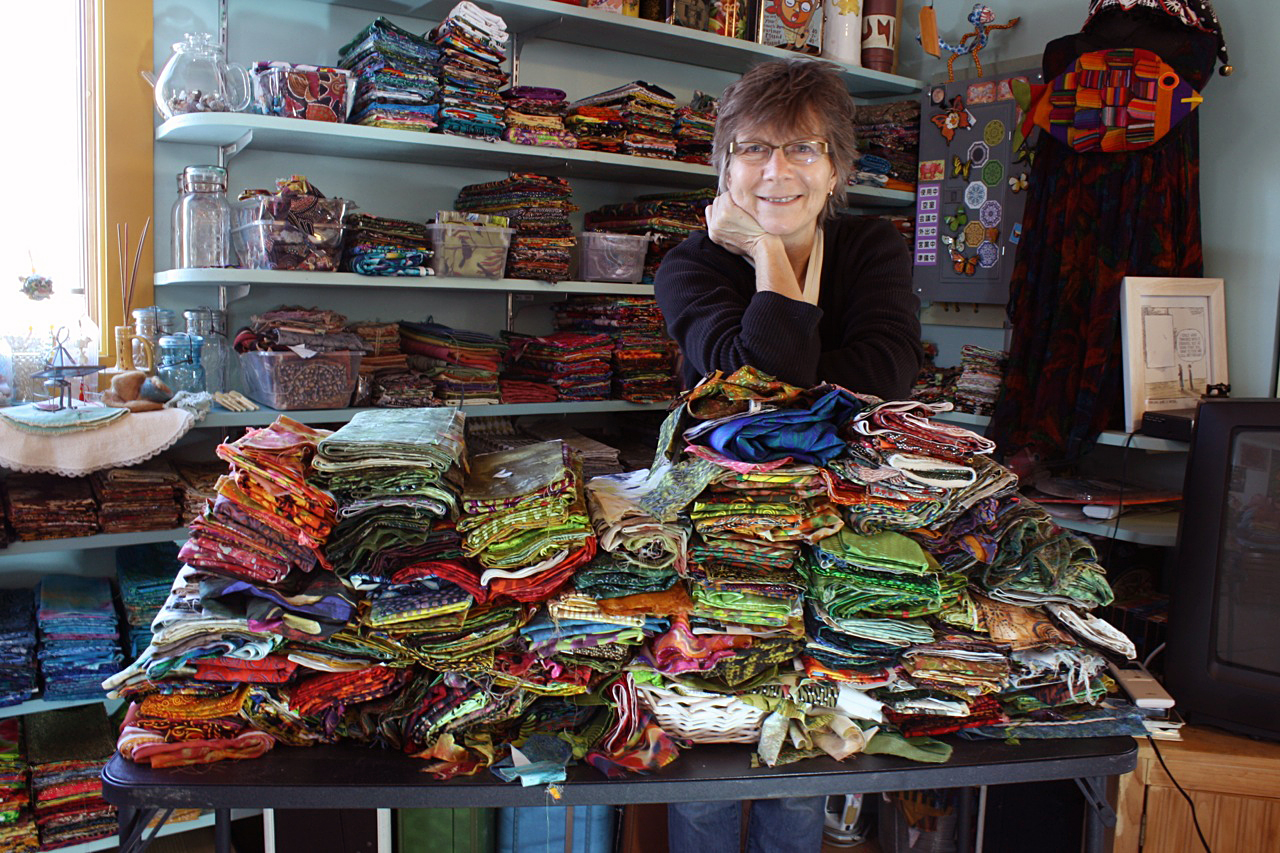
There are obvious ways to organize fabric:
- Color (reds, blues, greens)
- Pattern (Aboriginal, flowers and leaves, animal prints)
- Fiber content (cottons, synthetics, sheers)
- Novelty fabrics (butterflies, coral reef, maps)
Then there are less obvious (some known only to me) ways:
- Fabrics I collected on a particular trip (New Zealand, Yellowknife)
- Fabrics by a particular designer (Kaffe Fassett, Jane Sassaman)
- Future quilts I have in mind (Daisy, Hassan, and Max)
In order to categorize a particular fabric, I identify its most dominate characteristic. When I look at that fabric, what’s the first thing I think of? The fact that it’s a particular color may not be most important to me. In fact, I may have several fabrics of different colors but with the same pattern, all of which I group together in my head. If they coalesce in my brain, they probably ought to go together on the shelf.
So, in the winter of 2013 I built a new studio. Or rather, we had it built and Tom did a lot of the work himself. (See a future blog for that story.) This gave me the opportunity to set up my work space exactly how I would like it. I knew I would need a lot of shelf space, so Tom built me a whole wall of shelves.
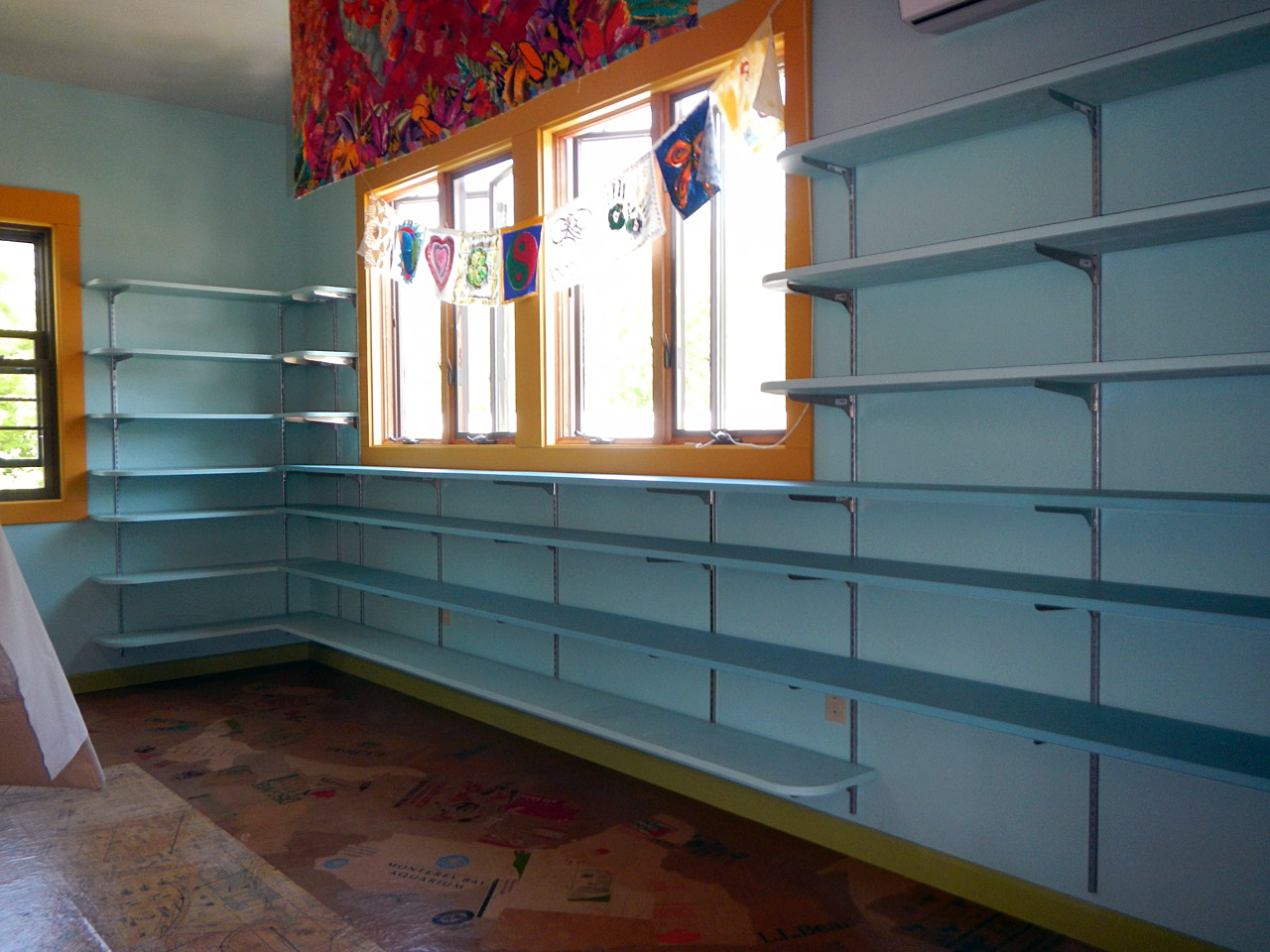
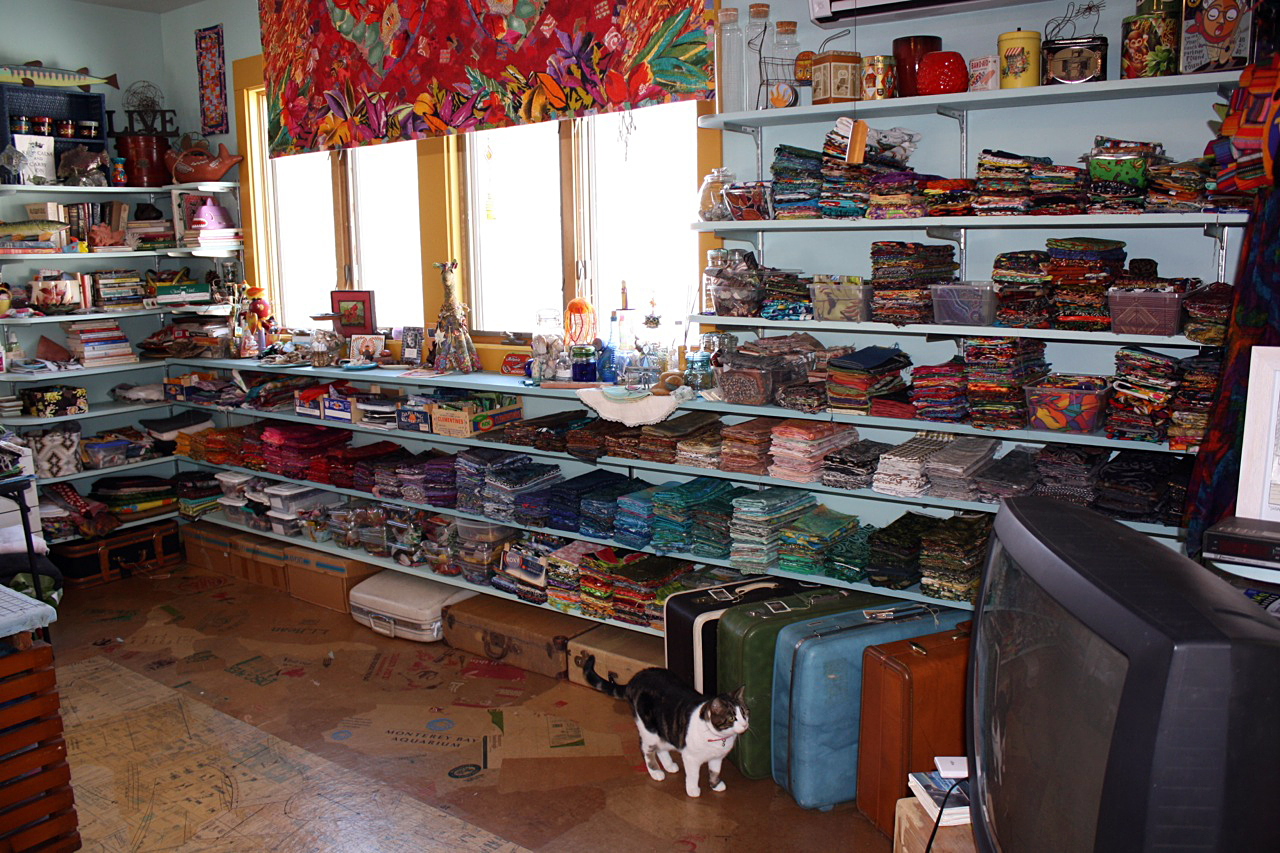
As you can see, the shelving fits a lot of fabric. Folded fabric. The larger pieces of fabric, up to a couple yards each. Most I organize by color and shades of color. For instance, there’s an orange pile, with red-orange next to that, followed by reds with a maroon cast, then magenta and pinks, purples, cool blues… you get the picture. It’s a rainbow. Blacks, browns, tan, beige, whites are in their own sequence on another shelf. With my palette, these don’t require as much space.
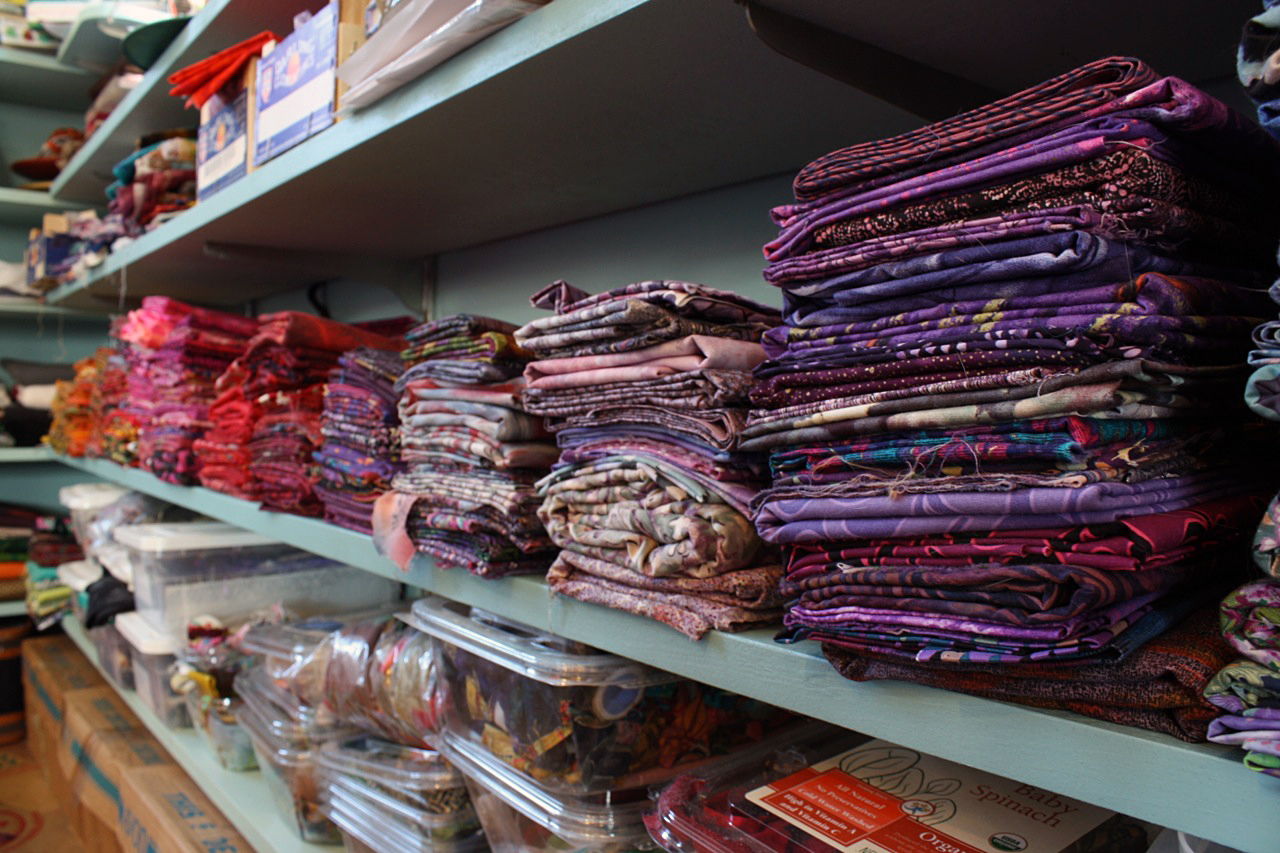
Certain chunks of fabric are big enough to fold, but would get lost in the shelves. These I store in clementine orange crates. You’ve probably seen them in the grocery store.
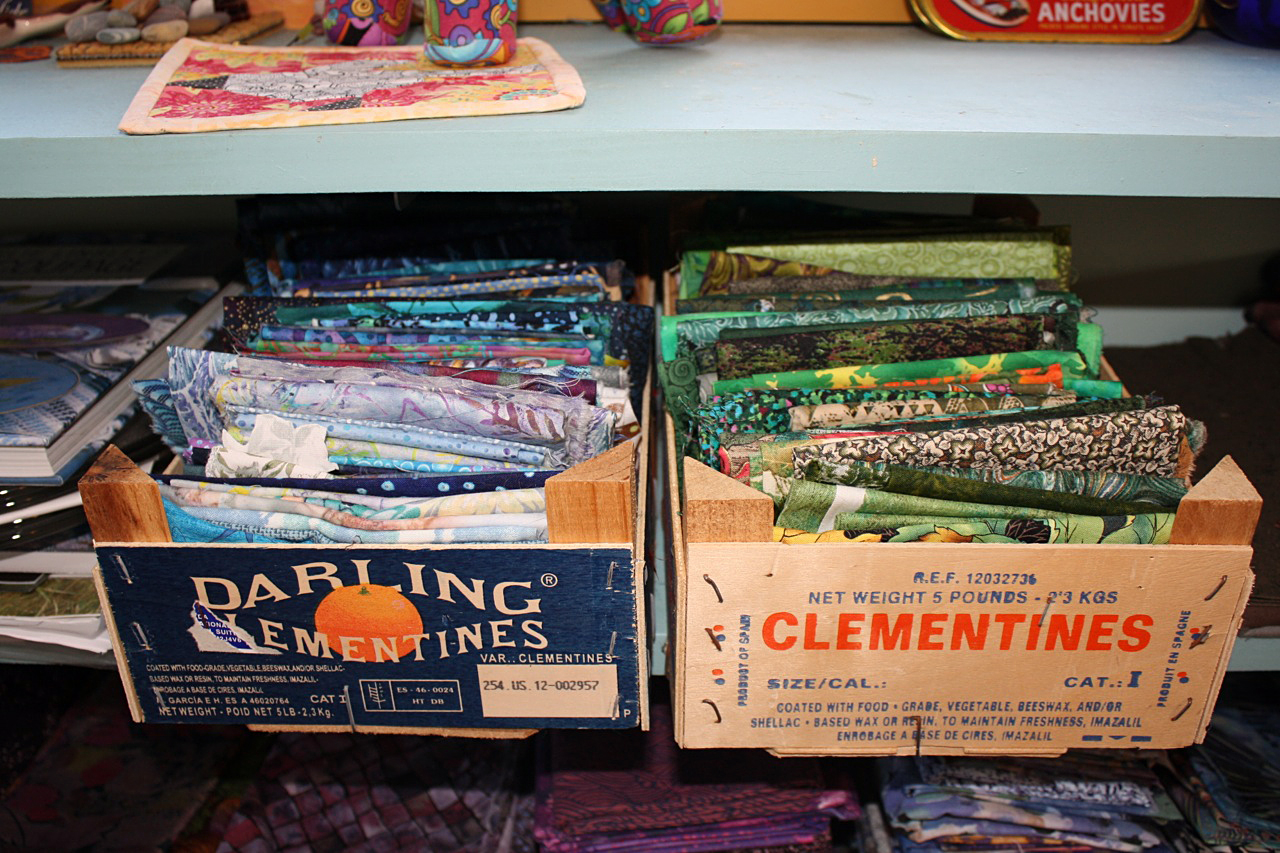
But there are even smaller pieces. As I cut up my fabric, I end up with odd, often quite small scraps. What do I do with all those pieces that other quilters would probably throw away? I have a couple of solutions.
Do you buy lettuce in plastic containers? Those things are great! They’re just the right size, they’re clear so you know what’s in them, and I feel good re-using them instead of discarding them, even if it’s off to be recycled. It’s easy to organize scraps either grocery-oriented way, by color or whatever criteria makes sense.
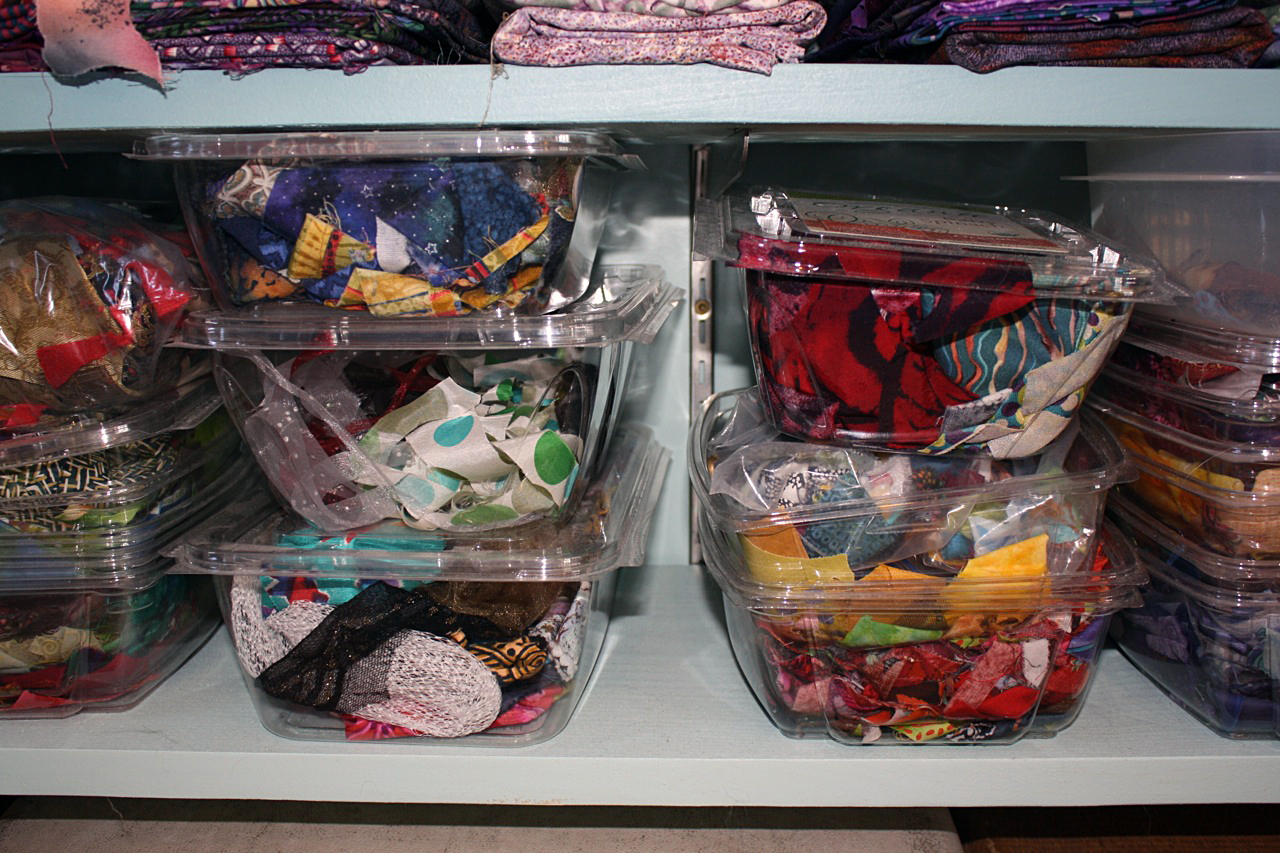
Sometimes the scraps build up, however, and drastic steps are necessary to find them a home. That’s where the suitcases come in. I collect those nostalgic, hard-cover suitcases. So far I have more than a dozen suitcases full of scraps (my husband made me stop counting), most bits no bigger than the palm of your hand.
The scraps I save are a great inspiration to me. In fact, I’ve created entire quilts out of scraps. For the quilt of my son Sam, “Samuelsaurus Rex,” I used the bits and pieces I had gathered just as they were, with almost no cutting whatsoever, using value as much as color to create a kinetic likeness of my little dinosaur lover.
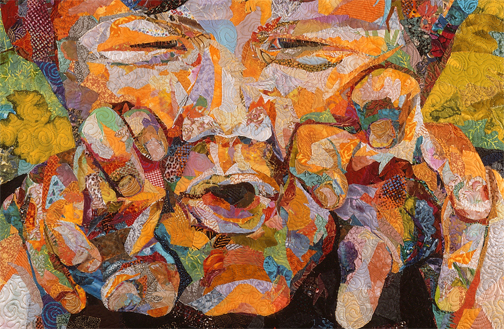
Whether on shelves, in transparent tubs, or tossed into a suiltcase, I need to be able to see it, touch it, compare it to others, hold it up to my quilts, or set it aside only to pick it up again later.
However fabric is stored it has to be accessible. I, and probably you since you made it to the end of this post, will always be attracted to fabric. It’s the fuel of our creations, or possibly just the way we decorate our shelves. But, if we’re lucky, we’ll re-discover that perfect piece at the perfect time. How else will fabric work its inspirational magic?
Do you have a good storage idea to add? Leave it in the comment section below!
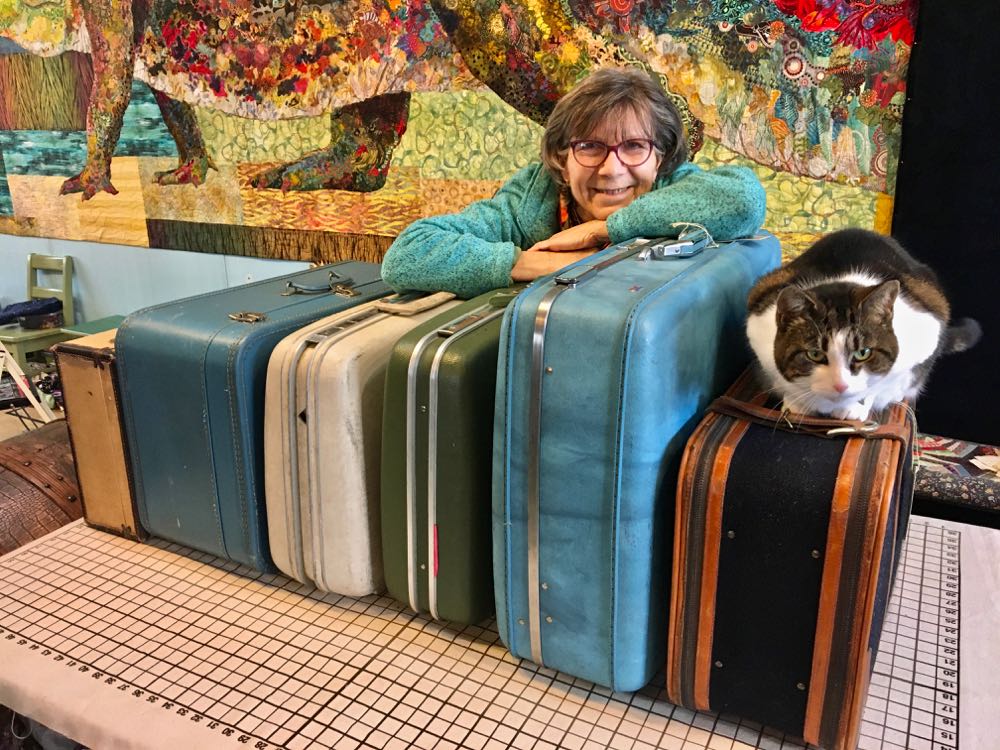
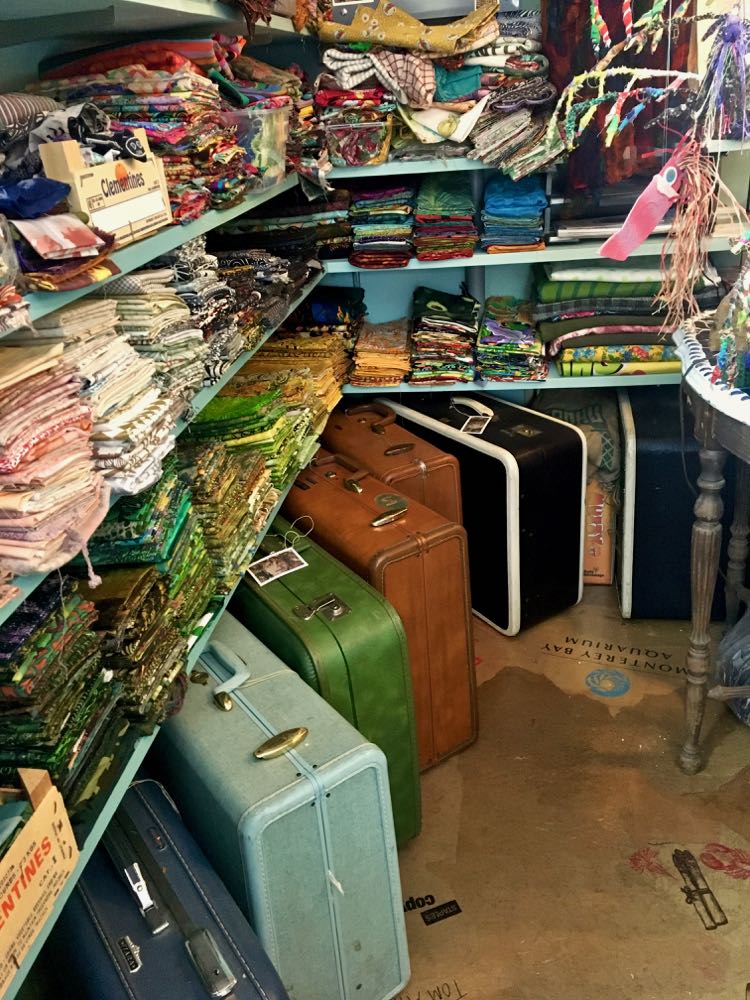
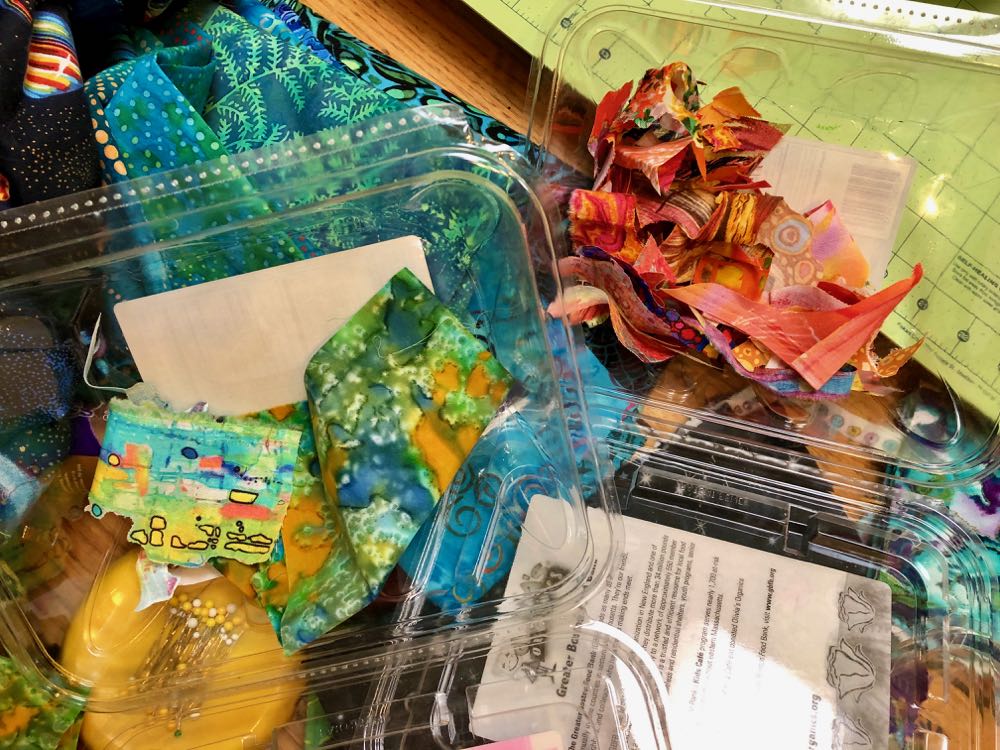
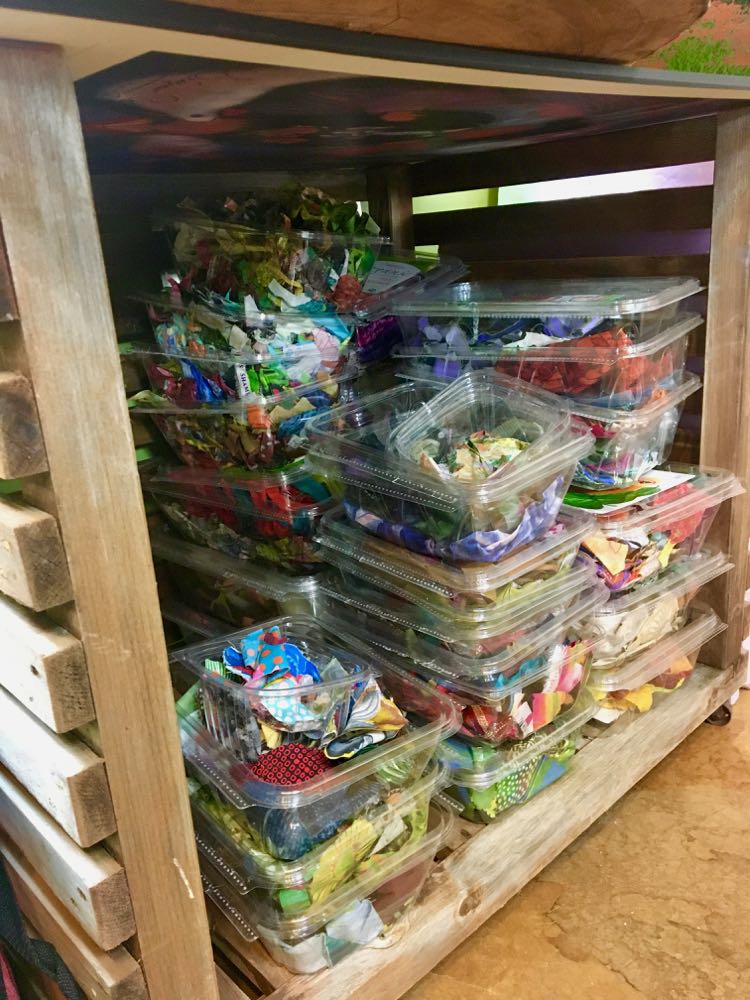
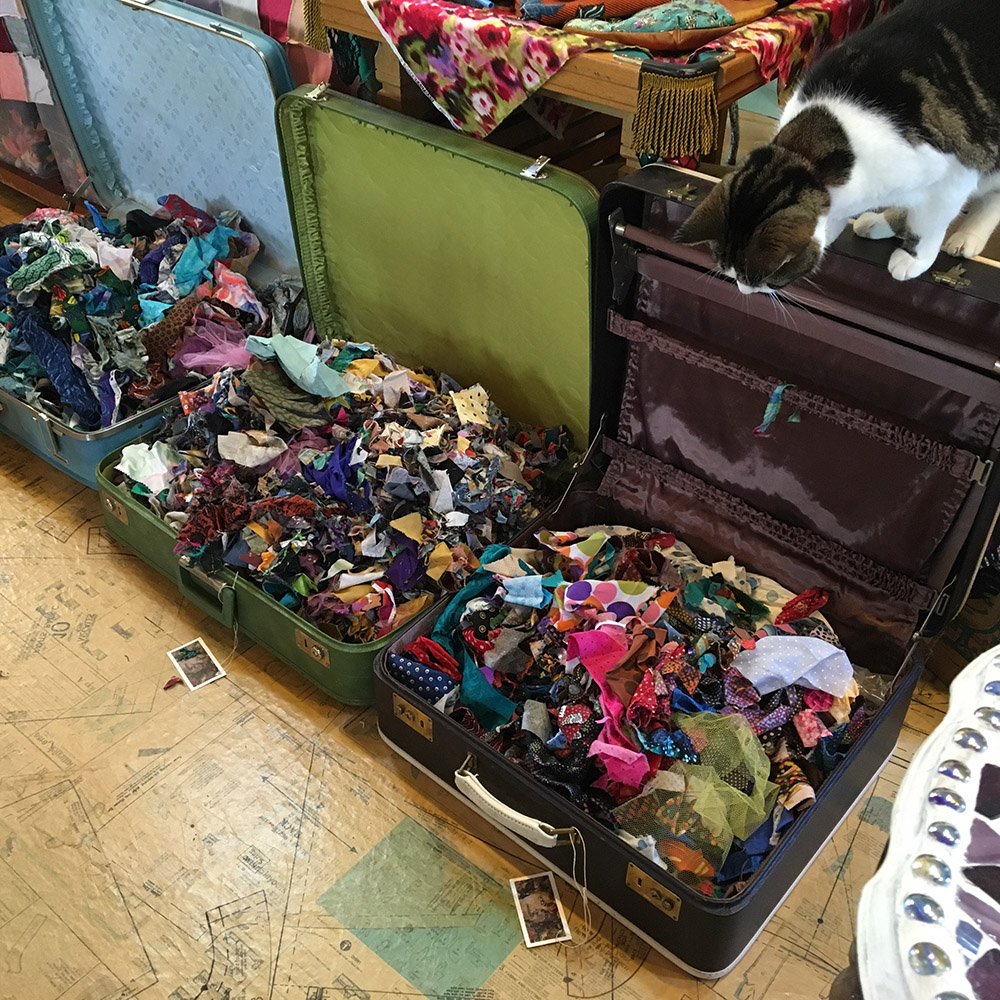
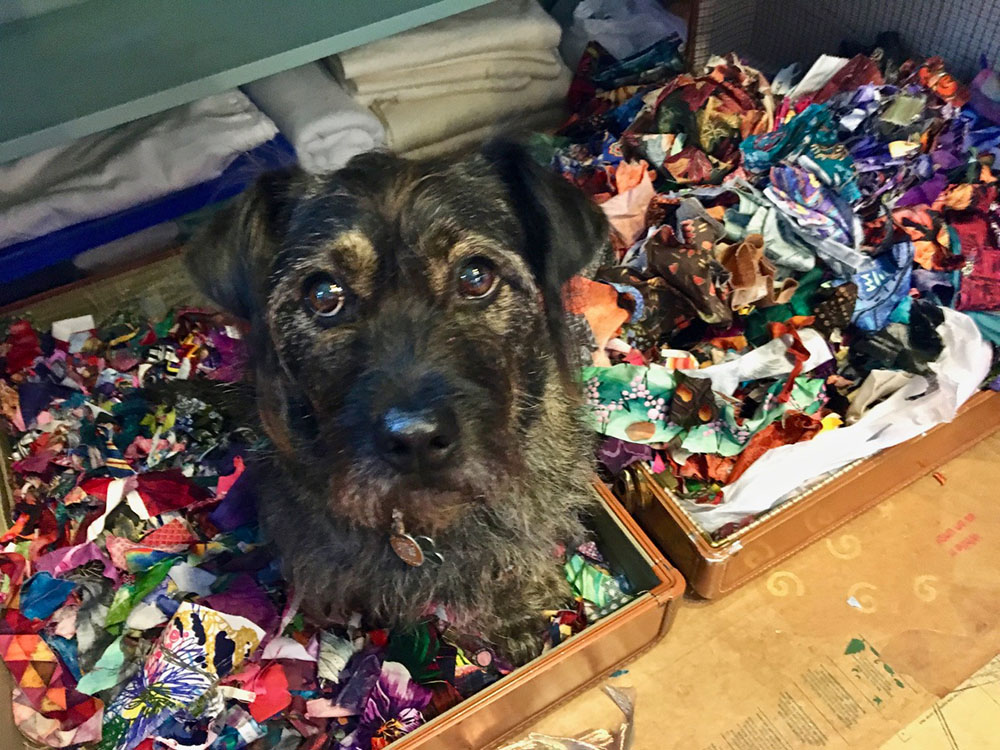
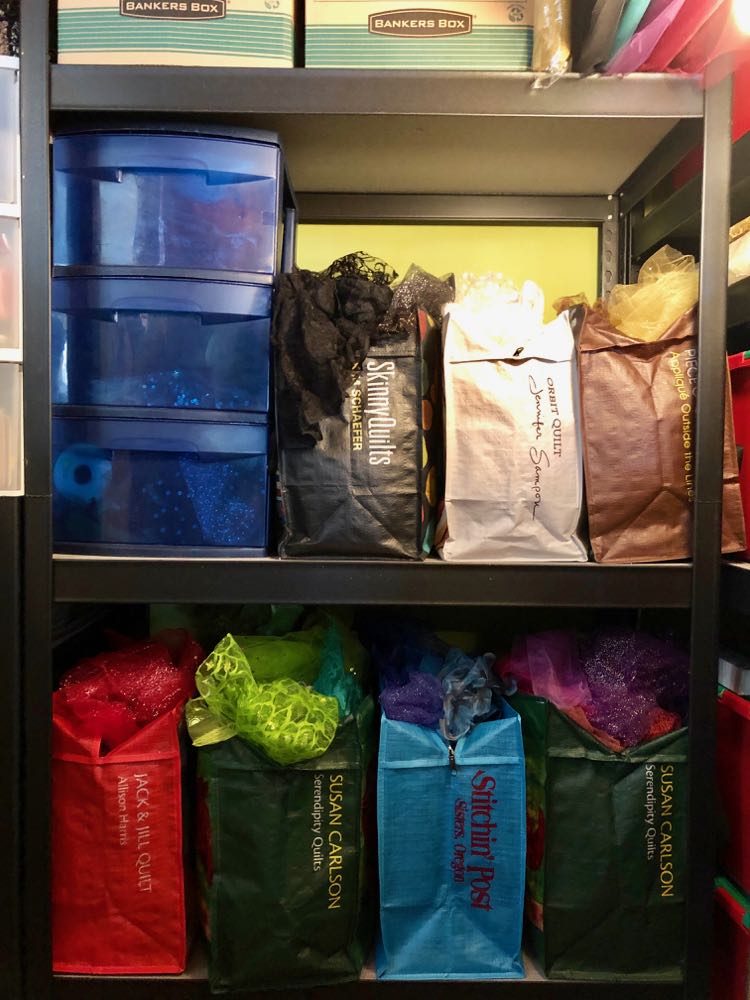
I’m sure your animals a glad you not traveling so much!!!
They are all so sweet.
I use Closetmaid 15 cubbie shoe organizers for my fabric. I can sort by color and theme. As far as my scraps go, I have glass jars that I sort them at that are from TJ Maxx and Marshalls. They are shaped like the commercial mayonnaise jars and also have about a six inch opening at the top. They also have a black oval on the front to mark the contents of the jar. Because I do all kinds of fabric work I have yo-yo jars and 2 x 2 jars as well as strips. I would put photos in but was unable to in this comment box. I’ll send the photos to you if you send me a link. Have a great day.
Loved this article, Susan…even your fabric-organizing is inspirational!! After taking a couple of your classes, I did adopt the plastic container idea and it is really great…I can just grab a container of black or red or purple or whatever when I am in the middle of something and just need a snip…and chances are, if I’ve used it before, it’s because I love the fabric, so want to use it again. Here’s hoping we all get to travel soon and take classes again, but til then, keep posting–I love reading your blog!!
Nice to have a fresh start to the year. I have used the lettuce containers but my IKEA shelving is deep and they get lost unless I get the extra large, then eat it all. Actually I only have completed two small collage ‘style’ projects, but started asking friends for their quilting scraps even before then.
I had also collected a bunch of zippered clear vinyl bag from the likes of curtains, bed sheets and blankets. This allows me to see what is within. Some have a top pocket which is handy for tiny pieces. These are mostly used for lace, tulles and slippery stuff. And the larger ones for batting.
A local fabric store outfitted her entire space with IKEA and I took the idea of the CD rack from her, they are terrific for fat quarter sized fabric. I have two that need a reboot today… or maybe tomorrow since I am heading to her store now for Superbowl Sunday sale!
Because I am a beginning fabric collager I have a small stash of scraps. I like the shallow berry containers. I don’t have to dig as far down. I’m sure I will need to grow into larger soon.
You obviously don’t mind a bit of cat hair in your stash. My cat has been happy with your influence. How do you keep cat hair under control?
I loved reading the original and “new and improved” report of sorting and storing your fabric. One thing I particularly identified with was the unique way we sometimes organize things that make perfect sense to us but don’t fit any logical description to others. And our ability to recall a certain fabric over decades–where we got it and where the scraps are located still.
And yet I can’t remember without a calendar what day it is. Lol
So happy I am not the only one recycling the lettuce containers! They are perfect!
Any tips on cleaning cat hair off my quilts?
Packing tape rolled into a loop with sticky side out. Gently pat the quilt. Use until stickiness is used up. Repeat.
Just found this wonderful information!!!! So enjoyed reading all about you and your great ideas!!! I don’t know where you are located, but I wish it was close to Texas! Sending a hug to you, Felix, and the cat!!!!!
Hi Barbara, had to smile at your comment. That particular post was already in the works for our Throwback Thursday post tomorrow—a sign that we made the correct choice! Hope others are as enthusiastic about it as you are! Thanks. We live in Maine, and I’ve given Felix and Djinni an extra hug from you (and Kali pup too so she doesn’t get jealous). 😉
Fresh off your in-person class in Bar Harbor and after reading this post, realized I brought a giant bag of little left over collage pieces that I never even looked at, preferring instead to cut even more little pieces out of new yardage. Just can’t help myself! So now more little left over pieces to categorize and put away in my bins and bags. This is what I would call a good problem to have. 🙂
I registered for an upcoming class and have enjoyed the wealth of information I’ve received already. Fabric. Before I made a quilt, an article of clothing or a collage, I collected fabric. As another commenter posted, I can tell you where I got each and every cut I have in my closet, folded on my shelving, or tossed into project baskets. I have nominally sorted fat quarters by color and put them into individual Sterlite boxes. But I can see I have to level up. Thanks for all the tips.